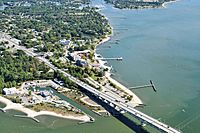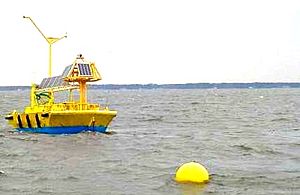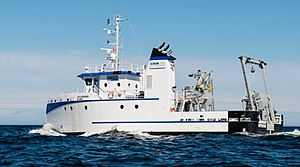Virginia Institute of Marine Science facts for kids

VIMS campus in Gloucester Point, Virginia
|
|
| Established | 1940 |
|---|---|
| Research type | Marine Sciences |
| Dean | John Wells |
| Director | John Wells |
| Location | Gloucester Point, Virginia |
The Virginia Institute of Marine Science (VIMS) is a big place in the United States where scientists study the ocean and teach about it. It started in 1940. VIMS is special because it's required by law to do research, teach, and give advice to the government, people, and businesses about the ocean. Money for VIMS comes from Virginia, government grants, and private donations.
The School of Marine Science at VIMS is the graduate school for ocean studies at William & Mary. Here, students can earn master's (M.S.) and doctorate (Ph.D.) degrees in marine science. The school has many teachers and around 80-100 students. VIMS' main campus is in Gloucester Point, Virginia.
Contents
What VIMS Does: Its Mission
VIMS does research, teaches, and gives advice about marine science. This helps Virginia, the United States, and the whole world. The work VIMS does is set out in the laws of Virginia.
The History of VIMS
VIMS began in 1938 as the William & Mary Maritime Laboratory. It was started by Professor Donald W. Davis. In 1940, Virginia officially made it the Virginia Fisheries Laboratory. Its first building, Maury Hall, is named after Matthew Fontaine Maury. He was a Virginian known as the "Father of Modern Oceanography."
In 1962, VIMS opened its Eastern Shore Laboratory in Wachapreague. This lab helped Virginia start a big industry for growing hard clams. In the 1960s, VIMS scientists also helped create important national programs. These included the Sea Grant and Coastal Zone Management programs.
Ocean Research Programs
VIMS scientists study many different things about the ocean. A study in 2009 showed that VIMS was among the top 1% of places for research. This was in the fields of Plant & Animal Science and Environment & Ecology.
Some early research programs included:
- Studying oysters in the 1950s. This work was very important for understanding how these shellfish live.
- Surveys of young fish and blue crabs in Chesapeake Bay. These started in 1955 and still help manage fisheries today.
- An annual shark survey that began in 1973. This is now the longest-running shark survey in the world.
- Efforts to bring back seagrass. These have been very successful, restoring over 6,000 acres (24 km2) in coastal bays.
Today, VIMS is actively researching:
- Coastal Research: Over 50 projects on coasts around the world, even in Antarctica.
- Blue Crab Health: How to keep blue crabs healthy and plentiful.
- Oyster Restoration: Bringing back oysters and growing them for food.
- Bay Grasses: Studying and restoring underwater plants.
- Aquatic Diseases: Learning about sicknesses in water animals and how they fight them.
- Fisheries and Aquaculture: Managing fish populations and farming seafood.
- Global Change: How big changes like climate change affect the ocean.
- Marine Life: Understanding how ocean animals and processes work.
- Observing & Modeling: Using computers and real-time data to predict things. This includes storm surges, how sand moves, and how ocean food webs work.
- Coastal Economies: How coastal areas make money and how people use them for fun.
- Pollution: Finding pollution in the ocean and understanding its risks.
Marine Science School
VIMS' School of Marine Science is one of four graduate schools at William & Mary. It has 57 teachers and about 80 to 100 students. About half of the students are women. Students can get master's (M.S.) and doctorate (Ph.D.) degrees in four main areas:
- Aquatic Health Sciences: Studying chemicals and other things that can harm water ecosystems.
- Biological Sciences: Looking at how living things, physical forces, and humans affect ocean ecosystems.
- Fisheries Science: Researching marine animals that are fished, especially finfish and shellfish.
- Physical Sciences: Studying the chemistry, geology, and physics of the ocean.
Facilities and Research Ships
VIMS has special labs at its Eastern Shore Laboratory and Kaufman Aquaculture Center. The main campus also has:
- The Seawater Research Laboratory: This is the biggest lab of its kind in the U.S. It can pump 800 gallons of seawater per minute to many research tanks and lab spaces.
- The William J. Hargis, Jr. Library: This library has over 88,000 books and other materials about marine science.
- Visitor Center: Here you can see aquariums and life-sized models. They show how VIMS research helps Chesapeake Bay and the ocean.
- Nunnally Ichthyology Collection: This collection has more than 125,000 fish specimens. They come from Chesapeake Bay and nearby waters.
- Andrews Hall: A large building with 39 labs and 25 faculty offices. It also has space for nearly 100 students and visiting scientists. This building houses centers for aquaculture, autonomous systems, and the bay grass program.
- Chesapeake Bay Hall: This facility has programs for studying ecology, pollution effects, fish genetics, and shellfish diseases.
VIMS also has a fleet of 40 research vessels (boats). Many are designed for research in Chesapeake Bay and other coastal areas. Some of the vessels include:
- R/V Virginia (93 feet): This ship was built for VIMS in 2018. It can be used by VIMS scientists and others. It's flexible for different science needs and can be used often. It helps with environmental studies and exploring offshore energy.
- R/V Bay Eagle (65 feet): This ship has a lab with a flowing seawater system. It also has changeable back decks. This makes it easy to switch between different tasks like trawling or dredging.
- R/V Tidewater (43 feet): This boat is made for doing trawl surveys, which means dragging a net to catch fish.
Satellite Campuses
- The Eastern Shore Laboratory: This lab is on the Virginia Eastern Shore. It's a place for field research and teaching. It's also known around the world for its shellfish research.
- The Kauffman Aquaculture Center: This center is located near the Rappahannock River. It has special facilities for VIMS' Aquaculture Genetics and Breeding Technology Center. This includes areas to keep native and non-native species separate.



